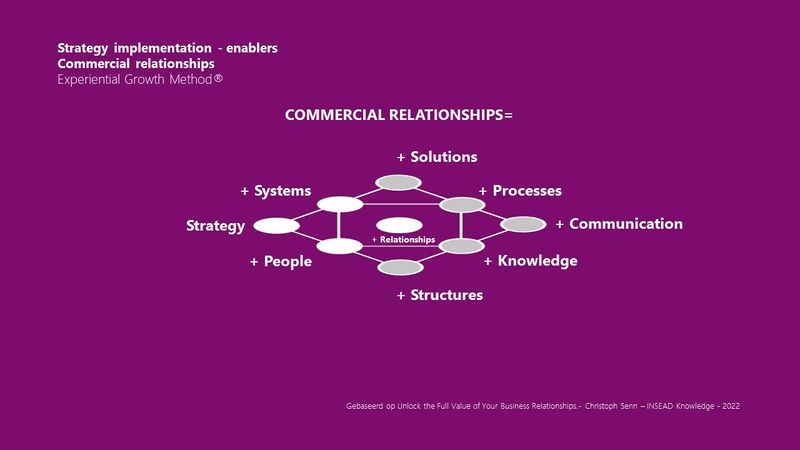Commercial relationships
Back to Commercial management
Welcome to the Commercial relationships page
From selling to co-creating
| In the traditional “value selling” approach, suppliers start by identifying customers whose needs best fit their products and develop a value proposition targeted at these customers. The tactic is focused on what a company’s products can do for the customer. However, the two parties should in fact be focused on creating value together. A good starting point is to ask the question: “What would we do differently, if we were one company?”
Studies of over 3,000 relationship cases show that only 15 percent of frontline sellers work with their clients based on this one-company mindset. By cocreating value, they could have doubled their account value in three years on average. Similarly, senior managers who adopt a customer-centric, value-creating perspective could have increased sales and profitability at twice the rate of their peers. Unfortunately, at 14 percent, they are but a minority of senior managers. (1) |
.
.
Triple fit canvas
| High-performing business relationships start with broader conversations about how to help clients create value, instead of trying to fit existing products into an existing strategy. These conversations involve “What can we do to improve the relationship?” or “What are our combined strengths and weaknesses?”
Triple fit takes a holistic view and prioritises value creation across three collaboration fit levels:
In essence, there are nine key components across these three fit levels. |
.
In practice, performing a triple fit process involves five steps
Step 1: The relationship maturity check
First, determine how well your company collaborates and communicates with its customers by rating ten statements (score = 1 to 5) about its relationship with each customer (from your customer’s perspective).
- Overall, we rate our relationship with (your company) as
- (Your company) uses a mutually-agreedupon collaboration strategy with us
- (Your company) maintains strong contacts, from the operational to the executive level, with us
- (Your company) communicates in an open, fair and forward-looking way with us
- (Your company) develops unique offerings and value propositions for us
- (Your company) aligns processes effectively and efficiently along our value chain
- (Your company) does business with us using compatible IT, finance and legal systems
- (Your company) assigns people with the ability to act as trusted advisers for us
- (Your company) provides cross-functional organisational and support structures for us
- (Your company) uses its knowledge to cocreate new, profitable business for us
To overcome self-reporting bias, involve your customers to rate the statements as well. Sharing your findings with customers not only serves to validate your assessment, but will also lead to aligned priorities and strategies.
.
Step 2: Identify areas for improvement
Based on the relationship maturity check, identify strengths that led to a high rating or weaknesses that prevented one. In areas where rating is low, ask why (up to five times) to identify the root cause, with the help of your customers.
.
Step 3: Develop viable solutions
With the results from step 2, explore ideas to boost value and mitigate risk. Start by asking what needs to be done to improve (or maintain) the situation, without jumping to conclusions (or actions) too quickly. Start by mapping the range of reasonable options, prioritise and select the most promising ideas, and validate their plausibility with the support of relevant stakeholders.
.
Step 4: Distinguish between long- and short-term actions
Then, group value-creation ideas into quick-win actions in the form of 90-day projects and longerterm initiatives of up to three years. To garner stakeholder support, describe exactly how each action will be executed and deliver value, including a robust estimate of investment and return.
.
Step 5: Get your stakeholders onboard
Finally, consolidate and summarise your triple-fit findings and pitch the central message to stakeholders. Efforts should be put into aligning product-minded salespeople to shift to big-picture thinking and collaborative value creation. At the management level, persuade senior leaders to adopt your central message, provide funding for your initiatives and accept both the benefits and risks.
.
Results
Results show that working with customers based on the mindset of “what if we were one company?” is the surer path to unlocking new sources of value. When revisited quarterly, the triple fit canvas not only helps companies to align their activities, it also helps them to keep the momentum and creates a significant difference to competitor approaches by moving beyond a product-focus to the full range of value creation.
| Source | |
|---|---|
| (1) | Customer-Centric Leadership: How to Manage Strategic Customers as Assets in B2B Markets - Christoph Senn - California Management Review - 2013 |
| Unlock the Full Value of Your Business Relationships - Christoph Senn - INSEAD Knowledge - 2022 |
